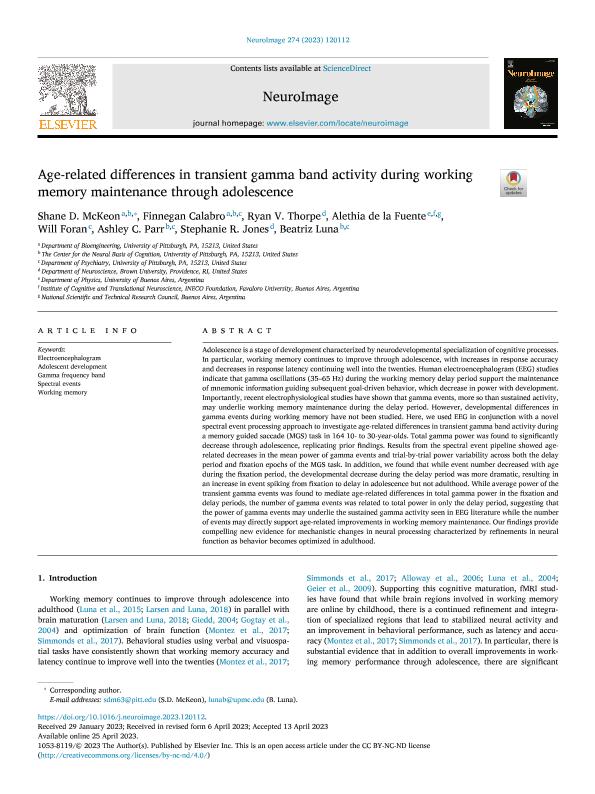Mostrar el registro sencillo del ítem
dc.contributor.author
McKeon, Shane D.
dc.contributor.author
Calabro, Finnegan
dc.contributor.author
Thorpe, Ryan V.
dc.contributor.author
de la Fuente de la Torre, Laura Alethia

dc.contributor.author
Foran, Will
dc.contributor.author
Parr, Ashley C.
dc.contributor.author
Jones, Stephanie R.
dc.contributor.author
Luna, Beatriz
dc.date.available
2023-11-28T15:24:01Z
dc.date.issued
2023-07
dc.identifier.citation
McKeon, Shane D.; Calabro, Finnegan; Thorpe, Ryan V.; de la Fuente de la Torre, Laura Alethia; Foran, Will; et al.; Age-related differences in transient gamma band activity during working memory maintenance through adolescence; Academic Press Inc.; Journal Neuroimag; 274; 120112; 7-2023; 1-11
dc.identifier.issn
1053-8119
dc.identifier.uri
http://hdl.handle.net/11336/218688
dc.description.abstract
Adolescence is a stage of development characterized by neurodevelopmental specialization of cognitive processes. In particular, working memory continues to improve through adolescence, with increases in response accuracy and decreases in response latency continuing well into the twenties. Human electroencephalogram (EEG) studies indicate that gamma oscillations (35–65 Hz) during the working memory delay period support the maintenance of mnemonic information guiding subsequent goal-driven behavior, which decrease in power with development. Importantly, recent electrophysiological studies have shown that gamma events, more so than sustained activity, may underlie working memory maintenance during the delay period. However, developmental differences in gamma events during working memory have not been studied. Here, we used EEG in conjunction with a novel spectral event processing approach to investigate age-related differences in transient gamma band activity during a memory guided saccade (MGS) task in 164 10- to 30-year-olds. Total gamma power was found to significantly decrease through adolescence, replicating prior findings. Results from the spectral event pipeline showed age-related decreases in the mean power of gamma events and trial-by-trial power variability across both the delay period and fixation epochs of the MGS task. In addition, we found that while event number decreased with age during the fixation period, the developmental decrease during the delay period was more dramatic, resulting in an increase in event spiking from fixation to delay in adolescence but not adulthood. While average power of the transient gamma events was found to mediate age-related differences in total gamma power in the fixation and delay periods, the number of gamma events was related to total power in only the delay period, suggesting that the power of gamma events may underlie the sustained gamma activity seen in EEG literature while the number of events may directly support age-related improvements in working memory maintenance. Our findings provide compelling new evidence for mechanistic changes in neural processing characterized by refinements in neural function as behavior becomes optimized in adulthood.
dc.format
application/pdf
dc.language.iso
eng
dc.publisher
Academic Press Inc.
dc.rights
info:eu-repo/semantics/openAccess
dc.rights.uri
https://creativecommons.org/licenses/by-nc-sa/2.5/ar/
dc.subject
ADOLESCENT DEVELOPMENT
dc.subject
ELECTROENCEPHALOGRAM
dc.subject
GAMMA FREQUENCY BAND
dc.subject
SPECTRAL EVENTS
dc.subject
WORKING MEMORY
dc.subject.classification
Otras Ciencias Naturales y Exactas

dc.subject.classification
Otras Ciencias Naturales y Exactas

dc.subject.classification
CIENCIAS NATURALES Y EXACTAS

dc.title
Age-related differences in transient gamma band activity during working memory maintenance through adolescence
dc.type
info:eu-repo/semantics/article
dc.type
info:ar-repo/semantics/artículo
dc.type
info:eu-repo/semantics/publishedVersion
dc.date.updated
2023-11-17T16:27:13Z
dc.journal.volume
274
dc.journal.number
120112
dc.journal.pagination
1-11
dc.journal.pais
Estados Unidos

dc.description.fil
Fil: McKeon, Shane D.. University of Pittsburgh at Johnstown; Estados Unidos. University of Pittsburgh; Estados Unidos
dc.description.fil
Fil: Calabro, Finnegan. Univeristy of Pittsburgh. School of Medicine; Estados Unidos. University of Pittsburgh at Johnstown; Estados Unidos. University of Pittsburgh; Estados Unidos
dc.description.fil
Fil: Thorpe, Ryan V.. University Brown; Estados Unidos
dc.description.fil
Fil: de la Fuente de la Torre, Laura Alethia. Consejo Nacional de Investigaciones Científicas y Técnicas; Argentina. Universidad de Buenos Aires; Argentina. Universidad Favaloro; Argentina
dc.description.fil
Fil: Foran, Will. Univeristy of Pittsburgh. School of Medicine; Estados Unidos
dc.description.fil
Fil: Parr, Ashley C.. Univeristy of Pittsburgh. School of Medicine; Estados Unidos
dc.description.fil
Fil: Jones, Stephanie R.. University Brown; Estados Unidos
dc.description.fil
Fil: Luna, Beatriz. Univeristy of Pittsburgh. School of Medicine; Estados Unidos
dc.journal.title
Journal Neuroimag

dc.relation.alternativeid
info:eu-repo/semantics/altIdentifier/doi/http://dx.doi.org/10.1016/j.neuroimage.2023.120112
dc.relation.alternativeid
info:eu-repo/semantics/altIdentifier/url/https://www.sciencedirect.com/science/article/pii/S1053811923002586
Archivos asociados
